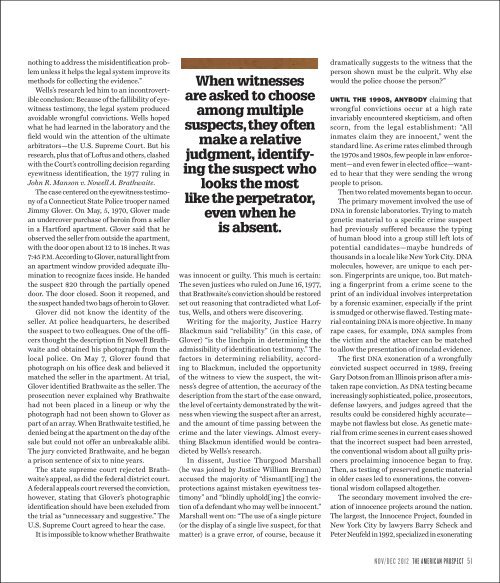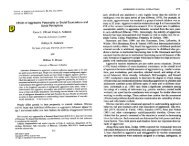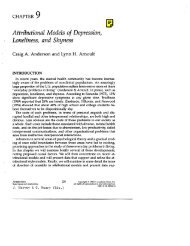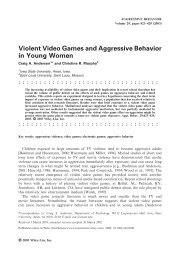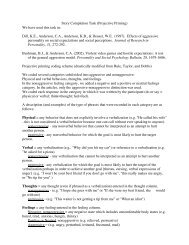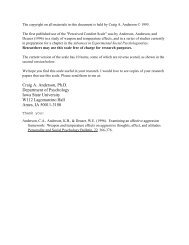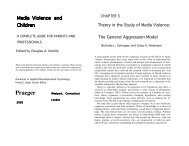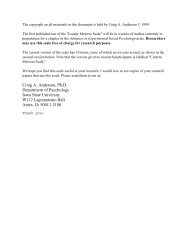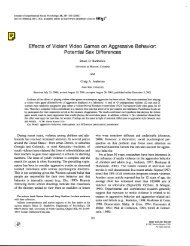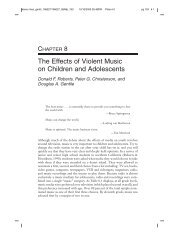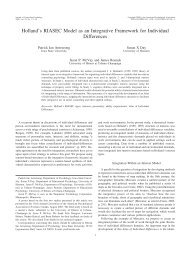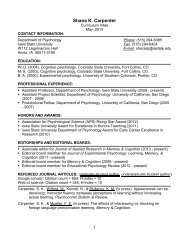Seeing is believing - Department of Psychology - Iowa State University
Seeing is believing - Department of Psychology - Iowa State University
Seeing is believing - Department of Psychology - Iowa State University
You also want an ePaper? Increase the reach of your titles
YUMPU automatically turns print PDFs into web optimized ePapers that Google loves.
nothing to address the m<strong>is</strong>identification problem<br />
unless it helps the legal system improve its<br />
methods for collecting the evidence.”<br />
Wells’s research led him to an incontrovertible<br />
conclusion: Because <strong>of</strong> the fallibility <strong>of</strong> eyewitness<br />
testimony, the legal system produced<br />
avoidable wrongful convictions. Wells hoped<br />
what he had learned in the laboratory and the<br />
field would win the attention <strong>of</strong> the ultimate<br />
arbitrators—the U.S. Supreme Court. But h<strong>is</strong><br />
research, plus that <strong>of</strong> L<strong>of</strong>tus and others, clashed<br />
with the Court’s controlling dec<strong>is</strong>ion regarding<br />
eyewitness identification, the 1977 ruling in<br />
John R. Manson v. Nowell A. Brathwaite.<br />
The case centered on the eyewitness testimony<br />
<strong>of</strong> a Connecticut <strong>State</strong> Police trooper named<br />
Jimmy Glover. On May, 5, 1970, Glover made<br />
an undercover purchase <strong>of</strong> heroin from a seller<br />
in a Hartford apartment. Glover said that he<br />
observed the seller from outside the apartment,<br />
with the door open about 12 to 18 inches. It was<br />
7:45 P.M. According to Glover, natural light from<br />
an apartment window provided adequate illumination<br />
to recognize faces inside. He handed<br />
the suspect $20 through the partially opened<br />
door. The door closed. Soon it reopened, and<br />
the suspect handed two bags <strong>of</strong> heroin to Glover.<br />
Glover did not know the identity <strong>of</strong> the<br />
seller. At police headquarters, he described<br />
the suspect to two colleagues. One <strong>of</strong> the <strong>of</strong>ficers<br />
thought the description fit Nowell Brathwaite<br />
and obtained h<strong>is</strong> photograph from the<br />
local police. On May 7, Glover found that<br />
photograph on h<strong>is</strong> <strong>of</strong>fice desk and believed it<br />
matched the seller in the apartment. At trial,<br />
Glover identified Brathwaite as the seller. The<br />
prosecution never explained why Brathwaite<br />
had not been placed in a lineup or why the<br />
photograph had not been shown to Glover as<br />
part <strong>of</strong> an array. When Brathwaite testified, he<br />
denied being at the apartment on the day <strong>of</strong> the<br />
sale but could not <strong>of</strong>fer an unbreakable alibi.<br />
The jury convicted Brathwaite, and he began<br />
a pr<strong>is</strong>on sentence <strong>of</strong> six to nine years.<br />
The state supreme court rejected Brathwaite’s<br />
appeal, as did the federal d<strong>is</strong>trict court.<br />
A federal appeals court reversed the conviction,<br />
however, stating that Glover’s photographic<br />
identification should have been excluded from<br />
the trial as “unnecessary and suggestive.” The<br />
U.S. Supreme Court agreed to hear the case.<br />
It <strong>is</strong> impossible to know whether Brathwaite<br />
When witnesses<br />
are asked to choose<br />
among multiple<br />
suspects, they <strong>of</strong>ten<br />
make a relative<br />
judgment, identifying<br />
the suspect who<br />
looks the most<br />
like the perpetrator,<br />
even when he<br />
<strong>is</strong> absent.<br />
was innocent or guilty. Th<strong>is</strong> much <strong>is</strong> certain:<br />
The seven justices who ruled on June 16, 1977,<br />
that Brathwaite’s conviction should be restored<br />
set out reasoning that contradicted what L<strong>of</strong>tus,<br />
Wells, and others were d<strong>is</strong>covering.<br />
Writing for the majority, Justice Harry<br />
Blackmun said “reliability” (in th<strong>is</strong> case, <strong>of</strong><br />
Glover) “<strong>is</strong> the linchpin in determining the<br />
adm<strong>is</strong>sibility <strong>of</strong> identification testimony.” The<br />
factors in determining reliability, according<br />
to Blackmun, included the opportunity<br />
<strong>of</strong> the witness to view the suspect, the witness’s<br />
degree <strong>of</strong> attention, the accuracy <strong>of</strong> the<br />
description from the start <strong>of</strong> the case onward,<br />
the level <strong>of</strong> certainty demonstrated by the witness<br />
when viewing the suspect after an arrest,<br />
and the amount <strong>of</strong> time passing between the<br />
crime and the later viewings. Almost everything<br />
Blackmun identified would be contradicted<br />
by Wells’s research.<br />
In d<strong>is</strong>sent, Justice Thurgood Marshall<br />
(he was joined by Justice William Brennan)<br />
accused the majority <strong>of</strong> “d<strong>is</strong>mantl[ing] the<br />
protections against m<strong>is</strong>taken eyewitness testimony”<br />
and “blindly uphold[ing] the conviction<br />
<strong>of</strong> a defendant who may well be innocent.”<br />
Marshall went on: “The use <strong>of</strong> a single picture<br />
(or the d<strong>is</strong>play <strong>of</strong> a single live suspect, for that<br />
matter) <strong>is</strong> a grave error, <strong>of</strong> course, because it<br />
dramatically suggests to the witness that the<br />
person shown must be the culprit. Why else<br />
would the police choose the person?”<br />
Until the 1990s, anybody claiming that<br />
wrongful convictions occur at a high rate<br />
invariably encountered skeptic<strong>is</strong>m, and <strong>of</strong>ten<br />
scorn, from the legal establ<strong>is</strong>hment: “All<br />
inmates claim they are innocent,” went the<br />
standard line. As crime rates climbed through<br />
the 1970s and 1980s, few people in law enforcement—and<br />
even fewer in elected <strong>of</strong>fice—wanted<br />
to hear that they were sending the wrong<br />
people to pr<strong>is</strong>on.<br />
Then two related movements began to occur.<br />
The primary movement involved the use <strong>of</strong><br />
DNA in forensic laboratories. Trying to match<br />
genetic material to a specific crime suspect<br />
had previously suffered because the typing<br />
<strong>of</strong> human blood into a group still left lots <strong>of</strong><br />
potential candidates—maybe hundreds <strong>of</strong><br />
thousands in a locale like New York City. DNA<br />
molecules, however, are unique to each person.<br />
Fingerprints are unique, too. But matching<br />
a fingerprint from a crime scene to the<br />
print <strong>of</strong> an individual involves interpretation<br />
by a forensic examiner, especially if the print<br />
<strong>is</strong> smudged or otherw<strong>is</strong>e flawed. Testing material<br />
containing DNA <strong>is</strong> more objective. In many<br />
rape cases, for example, DNA samples from<br />
the victim and the attacker can be matched<br />
to allow the presentation <strong>of</strong> ironclad evidence.<br />
The first DNA exoneration <strong>of</strong> a wrongfully<br />
convicted suspect occurred in 1989, freeing<br />
Gary Dotson from an Illino<strong>is</strong> pr<strong>is</strong>on after a m<strong>is</strong>taken<br />
rape conviction. As DNA testing became<br />
increasingly soph<strong>is</strong>ticated, police, prosecutors,<br />
defense lawyers, and judges agreed that the<br />
results could be considered highly accurate—<br />
maybe not flawless but close. As genetic material<br />
from crime scenes in current cases showed<br />
that the incorrect suspect had been arrested,<br />
the conventional w<strong>is</strong>dom about all guilty pr<strong>is</strong>oners<br />
proclaiming innocence began to fray.<br />
Then, as testing <strong>of</strong> preserved genetic material<br />
in older cases led to exonerations, the conventional<br />
w<strong>is</strong>dom collapsed altogether.<br />
The secondary movement involved the creation<br />
<strong>of</strong> innocence projects around the nation.<br />
The largest, the Innocence Project, founded in<br />
New York City by lawyers Barry Scheck and<br />
Peter Neufeld in 1992, specialized in exonerating<br />
nov/dec 2012 The American Prospect 51


